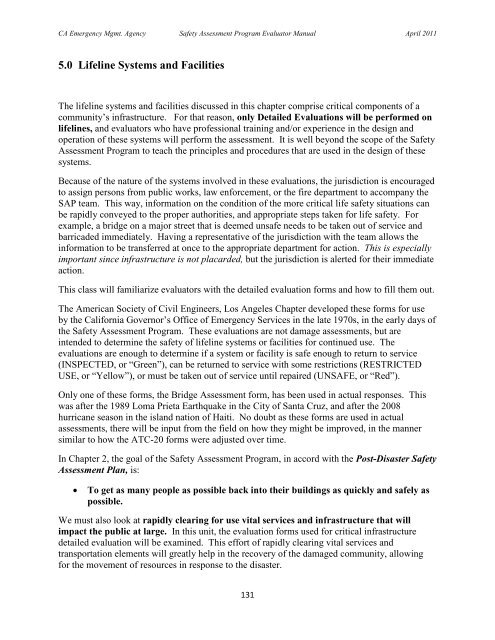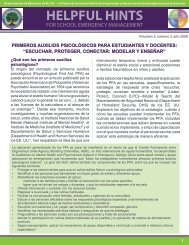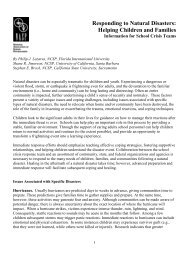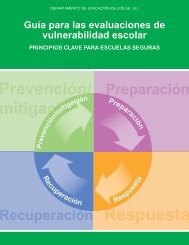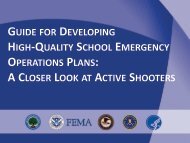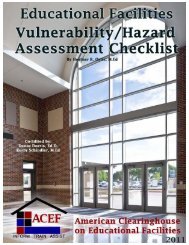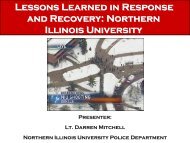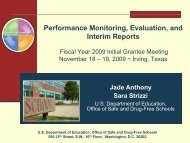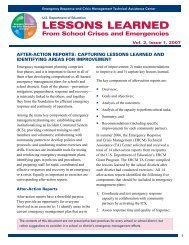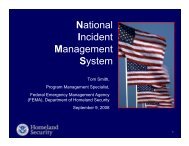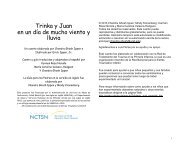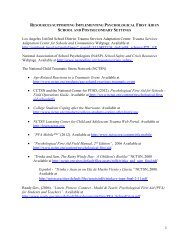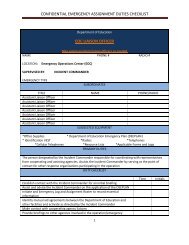Safety Assessment Program Evaluator Student Manual
Safety Assessment Program Evaluator Student Manual
Safety Assessment Program Evaluator Student Manual
You also want an ePaper? Increase the reach of your titles
YUMPU automatically turns print PDFs into web optimized ePapers that Google loves.
CA Emergency Mgmt. Agency <strong>Safety</strong> <strong>Assessment</strong> <strong>Program</strong> <strong>Evaluator</strong> <strong>Manual</strong> April 20115.0 Lifeline Systems and FacilitiesThe lifeline systems and facilities discussed in this chapter comprise critical components of acommunity‟s infrastructure. For that reason, only Detailed Evaluations will be performed onlifelines, and evaluators who have professional training and/or experience in the design andoperation of these systems will perform the assessment. It is well beyond the scope of the <strong>Safety</strong><strong>Assessment</strong> <strong>Program</strong> to teach the principles and procedures that are used in the design of thesesystems.Because of the nature of the systems involved in these evaluations, the jurisdiction is encouragedto assign persons from public works, law enforcement, or the fire department to accompany theSAP team. This way, information on the condition of the more critical life safety situations canbe rapidly conveyed to the proper authorities, and appropriate steps taken for life safety. Forexample, a bridge on a major street that is deemed unsafe needs to be taken out of service andbarricaded immediately. Having a representative of the jurisdiction with the team allows theinformation to be transferred at once to the appropriate department for action. This is especiallyimportant since infrastructure is not placarded, but the jurisdiction is alerted for their immediateaction.This class will familiarize evaluators with the detailed evaluation forms and how to fill them out.The American Society of Civil Engineers, Los Angeles Chapter developed these forms for useby the California Governor‟s Office of Emergency Services in the late 1970s, in the early days ofthe <strong>Safety</strong> <strong>Assessment</strong> <strong>Program</strong>. These evaluations are not damage assessments, but areintended to determine the safety of lifeline systems or facilities for continued use. Theevaluations are enough to determine if a system or facility is safe enough to return to service(INSPECTED, or “Green”), can be returned to service with some restrictions (RESTRICTEDUSE, or “Yellow”), or must be taken out of service until repaired (UNSAFE, or “Red”).Only one of these forms, the Bridge <strong>Assessment</strong> form, has been used in actual responses. Thiswas after the 1989 Loma Prieta Earthquake in the City of Santa Cruz, and after the 2008hurricane season in the island nation of Haiti. No doubt as these forms are used in actualassessments, there will be input from the field on how they might be improved, in the mannersimilar to how the ATC-20 forms were adjusted over time.In Chapter 2, the goal of the <strong>Safety</strong> <strong>Assessment</strong> <strong>Program</strong>, in accord with the Post-Disaster <strong>Safety</strong><strong>Assessment</strong> Plan, is:To get as many people as possible back into their buildings as quickly and safely aspossible.We must also look at rapidly clearing for use vital services and infrastructure that willimpact the public at large. In this unit, the evaluation forms used for critical infrastructuredetailed evaluation will be examined. This effort of rapidly clearing vital services andtransportation elements will greatly help in the recovery of the damaged community, allowingfor the movement of resources in response to the disaster.131


